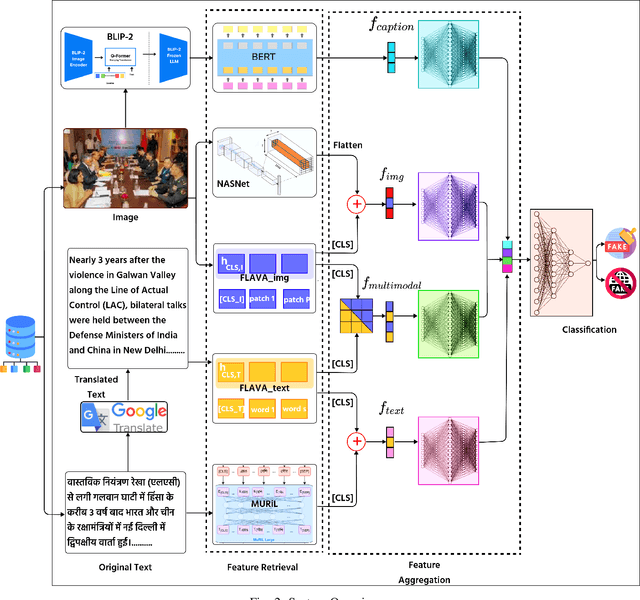Shahid Shafi Dar
MMCFND: Multimodal Multilingual Caption-aware Fake News Detection for Low-resource Indic Languages
Oct 14, 2024



Abstract:The widespread dissemination of false information through manipulative tactics that combine deceptive text and images threatens the integrity of reliable sources of information. While there has been research on detecting fake news in high resource languages using multimodal approaches, methods for low resource Indic languages primarily rely on textual analysis. This difference highlights the need for robust methods that specifically address multimodal fake news in Indic languages, where the lack of extensive datasets and tools presents a significant obstacle to progress. To this end, we introduce the Multimodal Multilingual dataset for Indic Fake News Detection (MMIFND). This meticulously curated dataset consists of 28,085 instances distributed across Hindi, Bengali, Marathi, Malayalam, Tamil, Gujarati and Punjabi. We further propose the Multimodal Multilingual Caption-aware framework for Fake News Detection (MMCFND). MMCFND utilizes pre-trained unimodal encoders and pairwise encoders from a foundational model that aligns vision and language, allowing for extracting deep representations from visual and textual components of news articles. The multimodal fusion encoder in the foundational model integrates text and image representations derived from its pairwise encoders to generate a comprehensive cross modal representation. Furthermore, we generate descriptive image captions that provide additional context to detect inconsistencies and manipulations. The retrieved features are then fused and fed into a classifier to determine the authenticity of news articles. The curated dataset can potentially accelerate research and development in low resource environments significantly. Thorough experimentation on MMIFND demonstrates that our proposed framework outperforms established methods for extracting relevant fake news detection features.
A Social Context-aware Graph-based Multimodal Attentive Learning Framework for Disaster Content Classification during Emergencies
Oct 11, 2024



Abstract:In times of crisis, the prompt and precise classification of disaster-related information shared on social media platforms is crucial for effective disaster response and public safety. During such critical events, individuals use social media to communicate, sharing multimodal textual and visual content. However, due to the significant influx of unfiltered and diverse data, humanitarian organizations face challenges in leveraging this information efficiently. Existing methods for classifying disaster-related content often fail to model users' credibility, emotional context, and social interaction information, which are essential for accurate classification. To address this gap, we propose CrisisSpot, a method that utilizes a Graph-based Neural Network to capture complex relationships between textual and visual modalities, as well as Social Context Features to incorporate user-centric and content-centric information. We also introduce Inverted Dual Embedded Attention (IDEA), which captures both harmonious and contrasting patterns within the data to enhance multimodal interactions and provide richer insights. Additionally, we present TSEqD (Turkey-Syria Earthquake Dataset), a large annotated dataset for a single disaster event, containing 10,352 samples. Through extensive experiments, CrisisSpot demonstrated significant improvements, achieving an average F1-score gain of 9.45% and 5.01% compared to state-of-the-art methods on the publicly available CrisisMMD dataset and the TSEqD dataset, respectively.
 Add to Chrome
Add to Chrome Add to Firefox
Add to Firefox Add to Edge
Add to Edge